Pecharsky V.K., Zavalij P.Y. Fundamentals of Powder Diffraction and Structural Characterization of Materials
Подождите немного. Документ загружается.


422 Chapter
5
reciprocal lattice. Certain
ab
initio indexing procedures, e.g. those that
are incorporated into
TREOR
and
IT0
(see sections
5.1
1.1
and
5.1
1.3
below), automatically skip some Bragg peaks that do not fit in a trial
lattice. This feature may help in indexing patterns containing some
impurities but on the other hand, it may also result in the incorrect,
usually overly simplified solution when Bragg peaks from a major phase
are accidentally excluded.
5.7
Cubic crystal system
Cubic symmetry of a material is always a good guess when a powder
diffraction pattern contains just a few peaks, or when there are sequences of
observed Bragg peaks that appear nearly equally spaced, especially at low
Bragg angles. Clearly, some experience in working with powder diffraction
data is needed to make this judgment from a visual analysis of
Y(8).
However, the ab initio indexing algorithm is so simple in the case of cubic
symmetry, that nearly always it is justifiable to attempt cubic indexing and
either confirm or dismiss this option.
When the crystal system is cubic, the general form of equation 5.2 is
simplified to
or in terms of the reciprocal lattice parameter
Since h,
k
and
1
are integers, the sums of their squares, (h2
+
k2
+
p),
are
also integer numbers. Thus, equation 5.12 can be written as follows
*
2
Qhkl
=
Ajk,a (5.13)
where Qjkl
=
d*2hkl
=
l/d2jkl and
Ahkl
=
(h2
+
k2
+
P).
The former is
established from the experiment for each Bragg peak using Eq. 5.3 and the
latter is a positive integer, which depends on the values of h,
k
and
I
in the
index triplet. Certain whole numbers, e.g.
7,
15 and others, given by

Unit cell determination and refinement
423
where i and
j
are positive integers, cannot be represented as a sum of squares
of any three integers and therefore, are forbidden in Eq. 5.13.
Assume that we have a set of experimental data where the observed
Bragg angles have been converted into an array of Q-values. Then, if the
crystal lattice is cubic, the following system of simultaneous equations can
be written to associate each Bragg peak with a certain combination of hkl
triplets:
As follows from the second form of Eq. 5.15, the observed array of
Q-
values should have a common divisor, which results in the array of integers
or nearly integers, considering the finite accuracy of the measured Bragg
angles. This common divisor is nothing else than the inverse of the square of
the edge of the cubic unit cell in the direct space since a*
=
lla.
The algorithm of indexing to test for cubic symmetry is shown in the
form of a flowchart in Figure
5.8.
After the array of Bragg angles have been
converted to Q-values, the next step is to normalize it and find the integers
A', A2,
.
.
.,
AN. The simplest way to do so is to divide all Q-values by the
smallest number present in the array, i.e. Qjlklll
=
Q'. If the resulting array of
A', A',
. .
.,
AN
contains whole numbers (to within a few hundredth's), the
lattice parameter is calculated and the corresponding values of the hikili
triplets are determined based on the values of
A'
after verification that no
forbidden integers (e.g.
7,
15, etc., see Eq. 5.14) are present in the array A.
When the first normalization step results in clearly non-integer values in
the array A, indexing still may be completed when the obtained A', A',
.
.
.,
AN are multiplied by 2, 3, 4, etc. If the crystal system is truly cubic, a simple
visual analysis of the array
A
after the first normalization usually enables one
to determine the needed integer multiplier easily. For example, when
decimal fractions of all A-values are close to 0 and 0.5, multiplying every
number in the array
A
by 2 will result in all integers. Similarly, when the
fractions are -0, -0.33 and -0.66, the multiplier is 3, and so on. When the
algorithm shown in Figure
5.8
is realized as a computer program then visual
analysis of data in
A
is usually impractical and the value of n is determined
automatically, based on somewhat arbitrary tolerances that establish which
value is taken as a whole number and which is not.
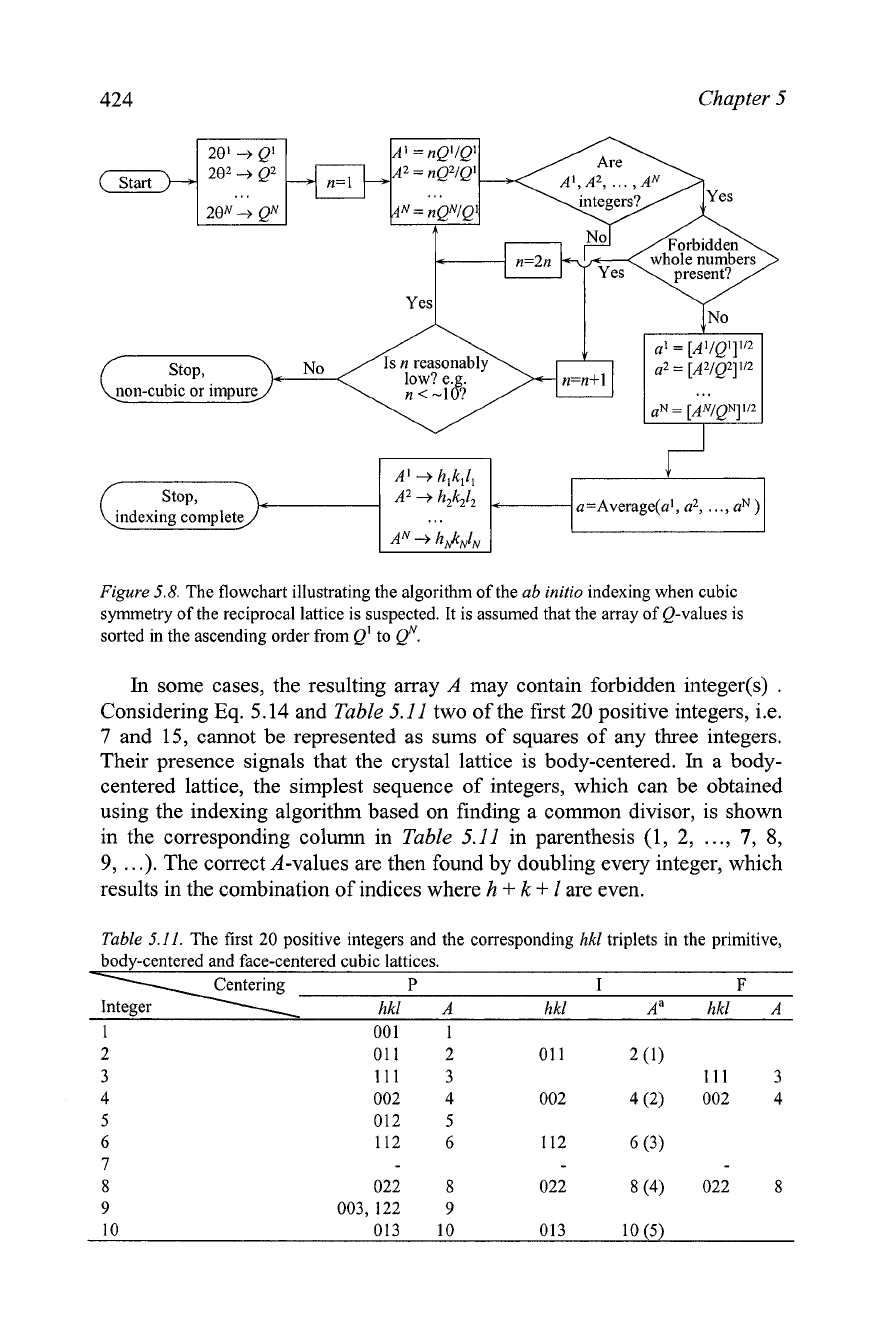
424
Chapter
5
Yes
Flgure
5.8.
The flowchart illustrating the algorithm of the
ab
initio
indexing when cubic
symmetry of the reciprocal lattice is suspected. It is assumed that the array of Q-values is
sorted in the ascending order from
Q'
to
@.
In
some cases, the resulting array
A
may contain forbidden integer(s)
.
Considering
Eq.
5.14 and
Table
5.11
two of the first
20
positive integers, i.e.
7
and 15, cannot be represented as sums of squares of any three integers.
Their presence signals that the crystal lattice is body-centered. In a body-
centered lattice, the simplest sequence of integers, which can be obtained
using the indexing algorithm based on finding a common divisor, is shown
in the corresponding column in
Table
5.11
in parenthesis
(1,
2,
...,
7,
8,
9,
.
.
.).
The correct A-values are then found by doubling every integer, which
results in the combination of indices where
h
+
k
+
1
are even.
Table
5.11.
The first 20 positive integers and the corresponding
hkl
triplets in the primitive,
body-centered and face-centered cubic lattices.
P
I
F
hkl
A
hkl
Aa
hkl
A
1
001
1
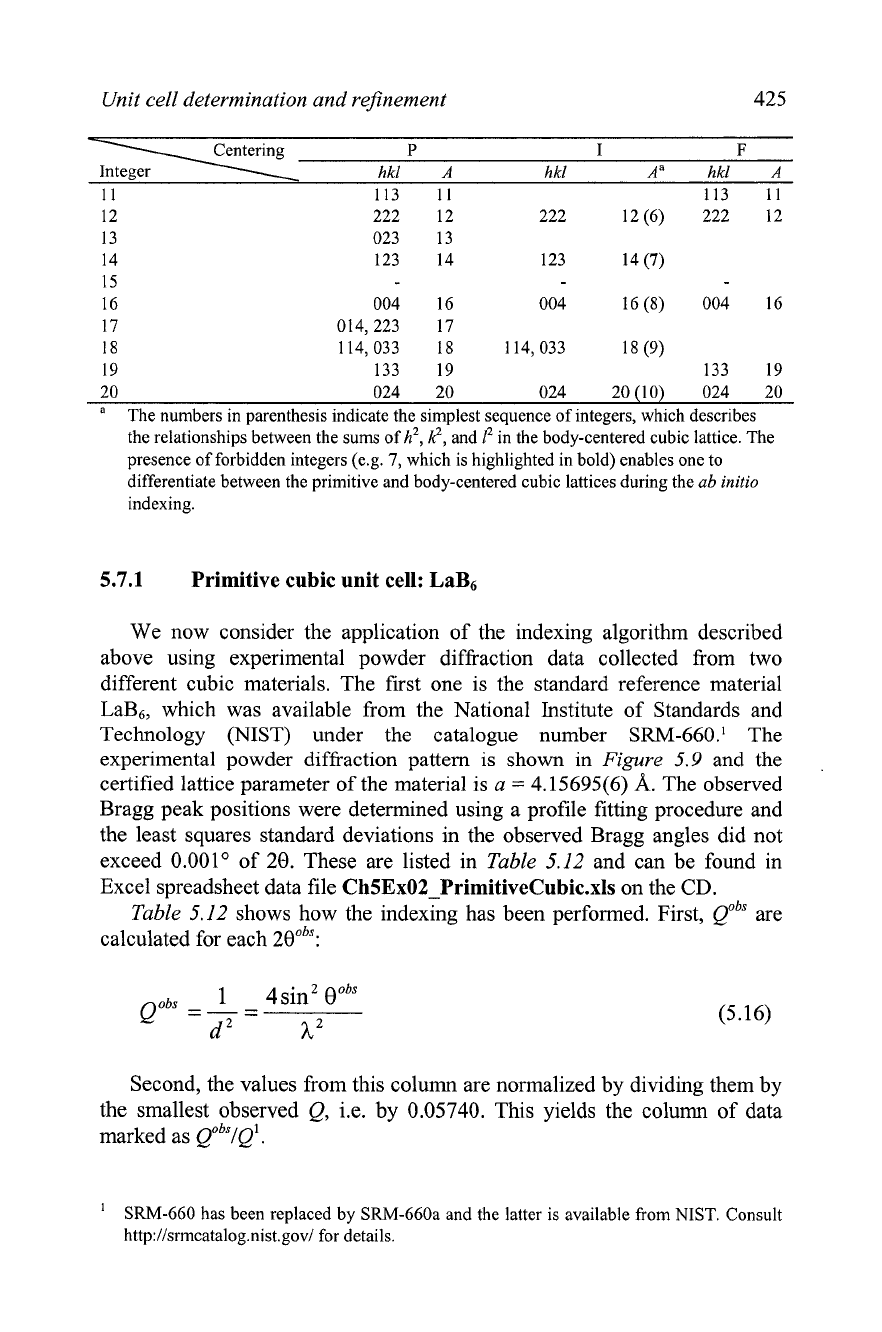
Unit cell determination and rejkement
425
P
I
F
hkl
A
hkl
Aa
hkl
A
11 113 11 113 11
20 024 20 024 20 (10) 024 20
a
The numbers in parenthesis indicate the simplest sequence of integers, which describes
the relationships between the sums of
h2,
2,
and
P
in the body-centered cubic lattice. The
presence of forbidden integers (e.g.
7,
which is highlighted in bold) enables one to
differentiate between the primitive and body-centered cubic lattices during the
ab
initio
indexing.
5.7.1
Primitive cubic unit cell:
LaBs
We now consider the application of the indexing algorithm described
above using experimental powder diffraction data collected from two
different cubic materials. The first one is the standard reference material
La&, which was available from the National Institute of Standards and
Technology (NIST) under the catalogue number SRM-660.' The
experimental powder diffraction pattern is shown in
Figure
5.9
and the
,
certified lattice parameter of the material is
a
=
4.15695(6)
A.
The observed
Bragg peak positions were determined using a profile fitting procedure and
the least squares standard deviations in the observed Bragg angles did not
exceed 0.001" of 20. These are listed in
Table
5.12
and can be found in
Excel spreadsheet data file
Ch5Ex02~PrimitiveCubic.xls
on the
CD.
Table
5.12
shows how the indexing has been performed. First, QobS are
calculated for each 20ObS:
Second, the values from this column are normalized by dividing them by
the smallest observed Q, i.e. by 0.05740. This yields the column of data
marked as QobS/Q'.
SRM-660 has been replaced by SRM-660a and the latter is available from NIST. Consult
http:Nsrmcatalog.nist.gov/
for details.
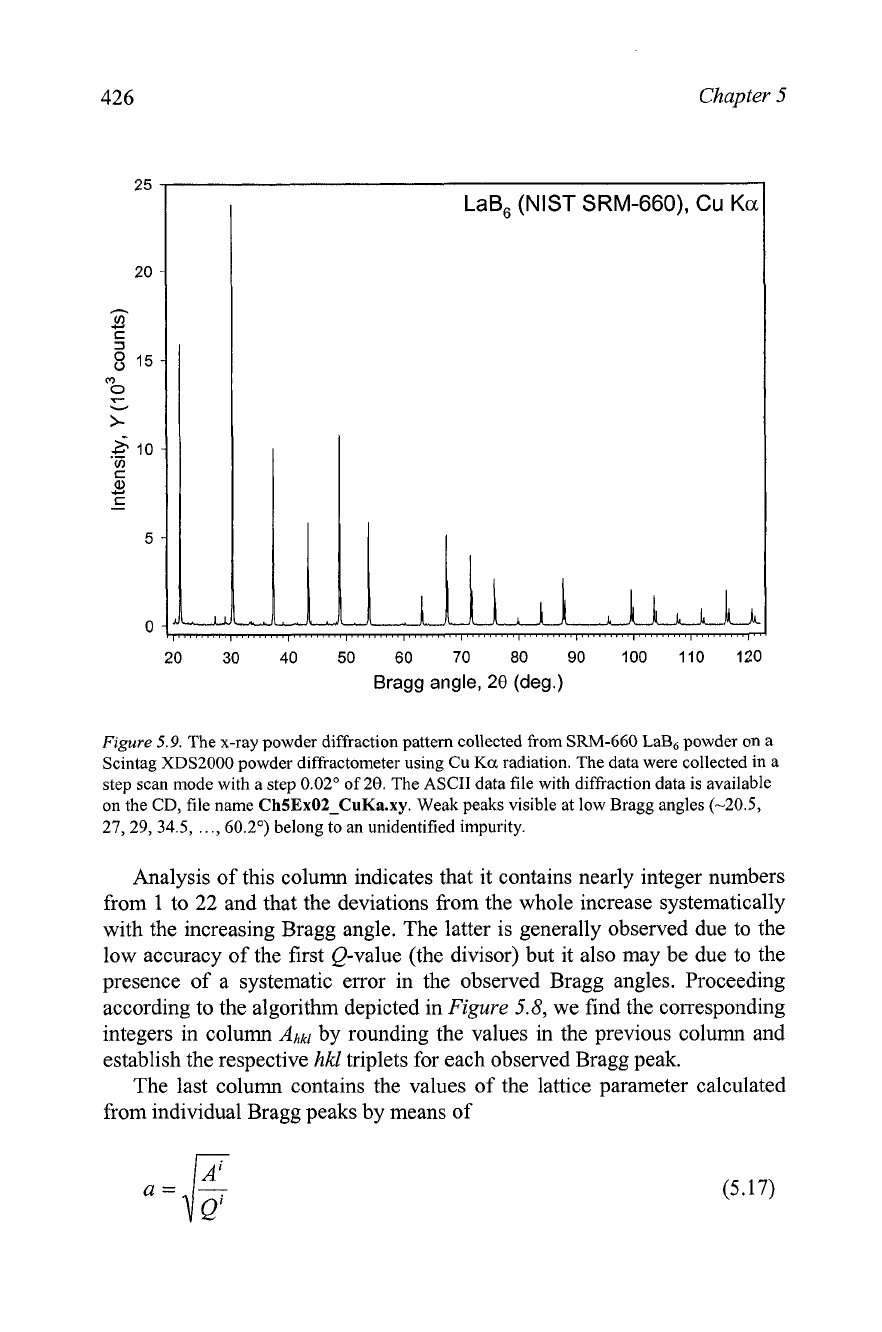
426
Chapter
5
LaB,
(NIST SRM-660),
Cu
Ka
20 30 40 50 60 70 80 90 100 110 120
Bragg
angle,
20
(deg.)
Figure
5.9.
The x-ray powder diffraction pattern collected from SRM-660 LaB, powder on a
Scintag XDS2000 powder diffractometer using
Cu
Ka
radiation. The data were collected in a
step scan mode with a step 0.02' of
20.
The ASCII data file with diffraction data is available
on the CD, file name
ChSExOZ-CuKa.xy.
Weak peaks visible at low Bragg angles (-20.5,
27,29,
34.5,
..
., 60.2") belong to an unidentified impurity.
Analysis of this column indicates that it contains nearly integer numbers
from 1 to
22
and that the deviations from the whole increase systematically
with the increasing Bragg angle. The latter is generally observed due to the
low accuracy of the first Q-value (the divisor) but it also may be due to the
presence of a systematic error in the observed Bragg angles. Proceeding
according to the algorithm depicted in
Figure
5.8,
we find the corresponding
integers in column
Ahkl
by rounding the values in the previous column and
establish the respective
hkl
triplets for each observed Bragg peak.
The last column contains the values of the lattice parameter calculated
from individual Bragg peaks by means of
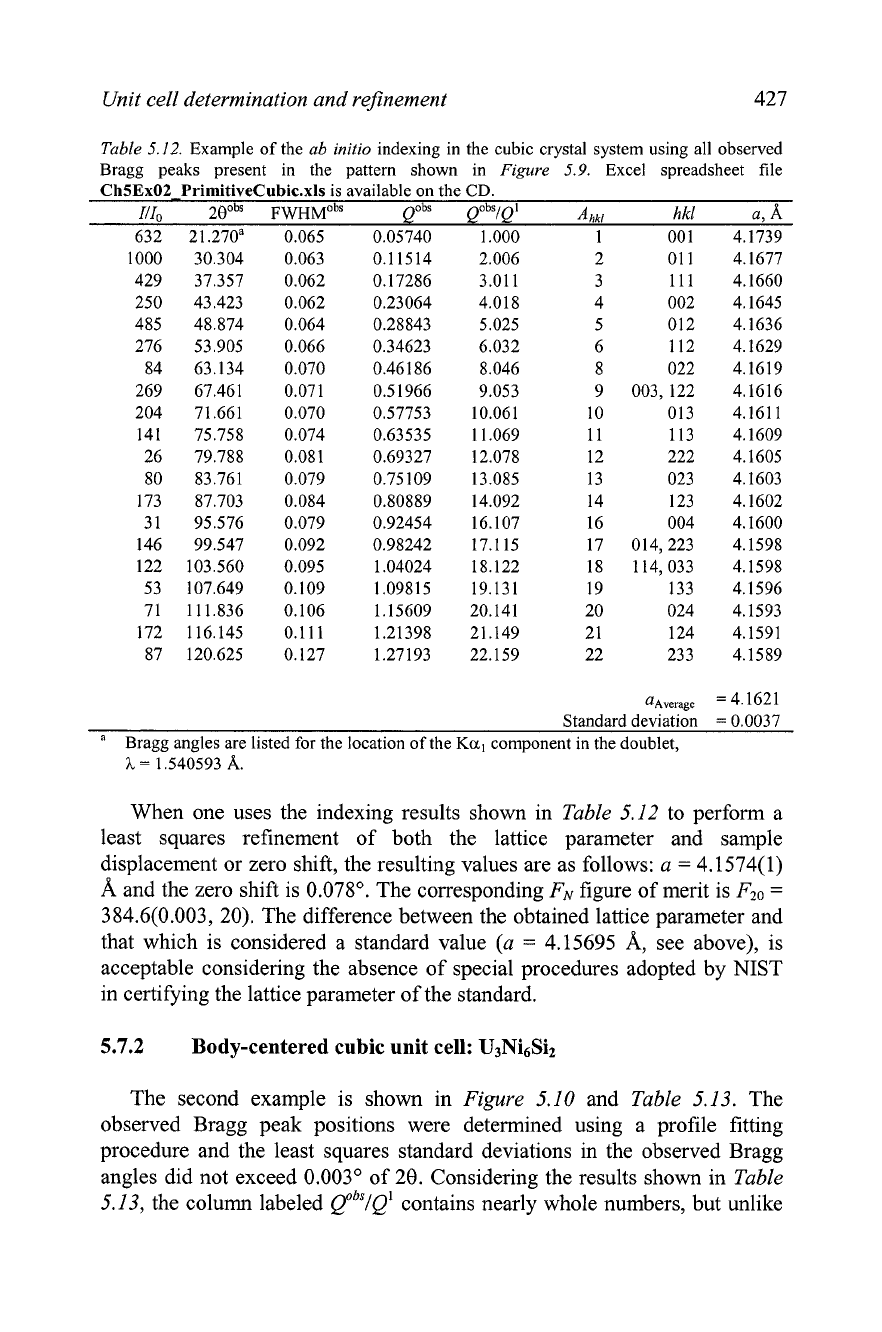
Unit cell determination and rejnement
427
Table
5.12.
Example of the
ab
initio
indexing in the cubic crystal system using all observed
Bragg peaks present in the pattern shown in
Figure
5.9.
Excel spreadsheet file
ChSEx02
PrimitiveCubic.xls
is available on the
CD.
14,
2BobS
FWHM'~~
obs
Q"~"Q'
Ahkl
hkl
a,
8,
632 21.270a 0.065 0.05740
1
.OOO 1 001 4.1739
Standard deviation
=
0.0037
"
Bragg angles are listed for the location of the
KCL,
component in the doublet,
h
=
1
S40593
A.
When one uses the indexing results shown in
Table
5.12 to perform a
least squares refinement of both the lattice parameter and sample
displacement or zero shift, the resulting values are as follows:
a
=
4.1574(1)
A
and the zero shift is 0.078". The corresponding
FN
figure of merit is
FZ0
=
384.6(0.003, 20). The difference between the obtained lattice parameter and
that which is considered a standard value
(a
=
4.15695 A, see above), is
acceptable considering the absence of special procedures adopted by
NIST
in certifying the lattice parameter of the standard.
5.7.2
Body-centered cubic unit cell:
U3Ni6Si2
The second example is shown in
Figure
5.10 and
Table
5.13. The
observed Bragg peak positions were determined using a profile fitting
procedure and the least squares standard deviations in the observed Bragg
angles did not exceed 0.003" of 28. Considering the results shown in
Table
5.13, the column labeled
QObS/~'
contains nearly whole numbers, but unlike

42 8 Chapter
5
the identical column in Table 5.12, here one finds forbidden integer values:
7,
15
and
23
(all three are highlighted in bold in Table 5.13).
Thus, the column labeled
Ahkl
is obtained by rounding the values from the
previous column and multiplying them by 2. The corresponding hkl triplets
confirm a body-centered lattice (h
+
k
+
1
=
2n), and the last column contains
the values of the lattice parameter calculated from the individual Bragg
peaks using
Eq.
5.17.
Even though the numbers in the column
Q"~~IQ'
still show a systematic
increase in the deviations from whole numbers (the reason is the low
absolute accuracy of the divisor,
Q'
=
0.02682), the lattice parameters listed
in the last column do not reveal the presence of any kind of a systematic
error in the observed Bragg angles. Using the average lattice parameter, a
=
8.6443
A,
the indexing result listed in Table
5.13
yields
F2,,
=
194.7(0.005,22): two of the first 22 Bragg peaks are not observed in this
diffraction pattern (233 and 062) and one whole number (28) is forbidden.
A
least squares refinement yields the unit cell dimension nearly identical to the
01
I0 20 30 40 50 60 70 80 90 100 110 120 130
Bragg angle,
28
(deg.)
Figure
5.10.
The x-ray powder diffraction pattern of U3Ni6Si2 collected on an HZG-4a
powder diffractometer using filtered Cu
Ka
radiation. The data were collected in a step scan
mode with a step 0.02" of 20 and counting time 25 sec. The ASCII data file with the
diffraction data is available on the CD, file name
ChSEx03-CuKa.xy.
Data courtesy of Dr.
L.G. Akselrud. When compared, for example, with
Figure
5.5
and
Figure
5.9,
the increased
background is noteworthy, which occurs as a result of its incomplete elimination when using
a p-filter.
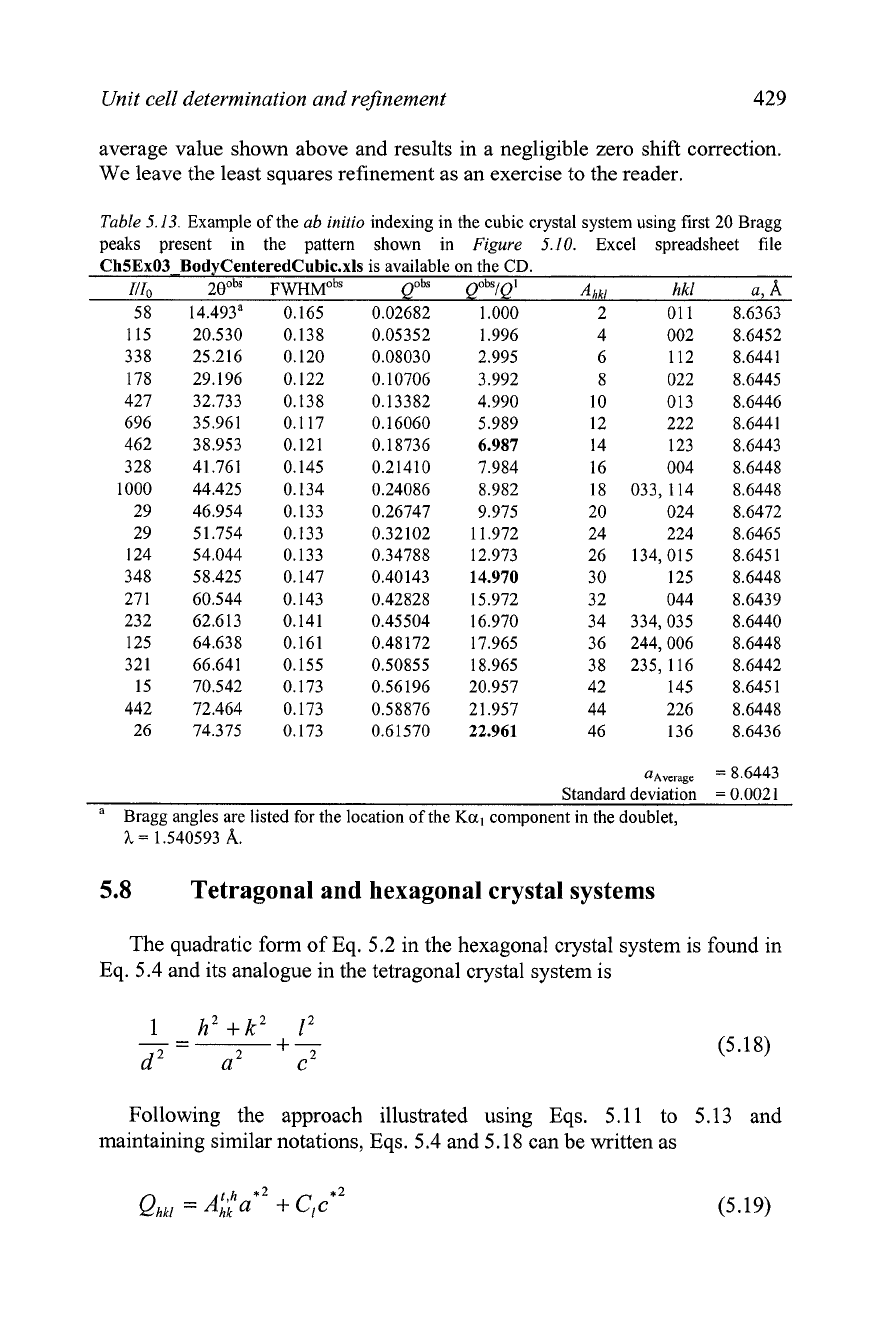
Unit cell determination and rejkement
429
average value shown above and results in a negligible zero shift correction.
We
leave the least squares refinement as an exercise to the reader.
Table 5.13.
Example of the
ab initio
indexing in the cubic crystal system using first
20
Bragg
peaks present in the pattern shown in
Figure
5.10.
Excel spreadsheet file
ChSEx03 BodyCenteredCubic.xls
is available on the
CD.
r/ro
2eobS
FWHMO~"
obs
obsl
I
Ahkl
hkl
a,
A
Standard deviation
=
0.0021
a
Bragg angles are listed for the location of the
Ka,
component in the doublet,
h
=
1.540593
A.
5.8
Tetragonal and hexagonal crystal systems
The quadratic form of Eq. 5.2 in the hexagonal crystal system is found in
Eq. 5.4 and its analogue in the tetragonal crystal system is
Following the approach illustrated using Eqs. 5.1 1 to 5.13 and
maintaining similar notations, Eqs. 5.4 and 5.18 can be written as
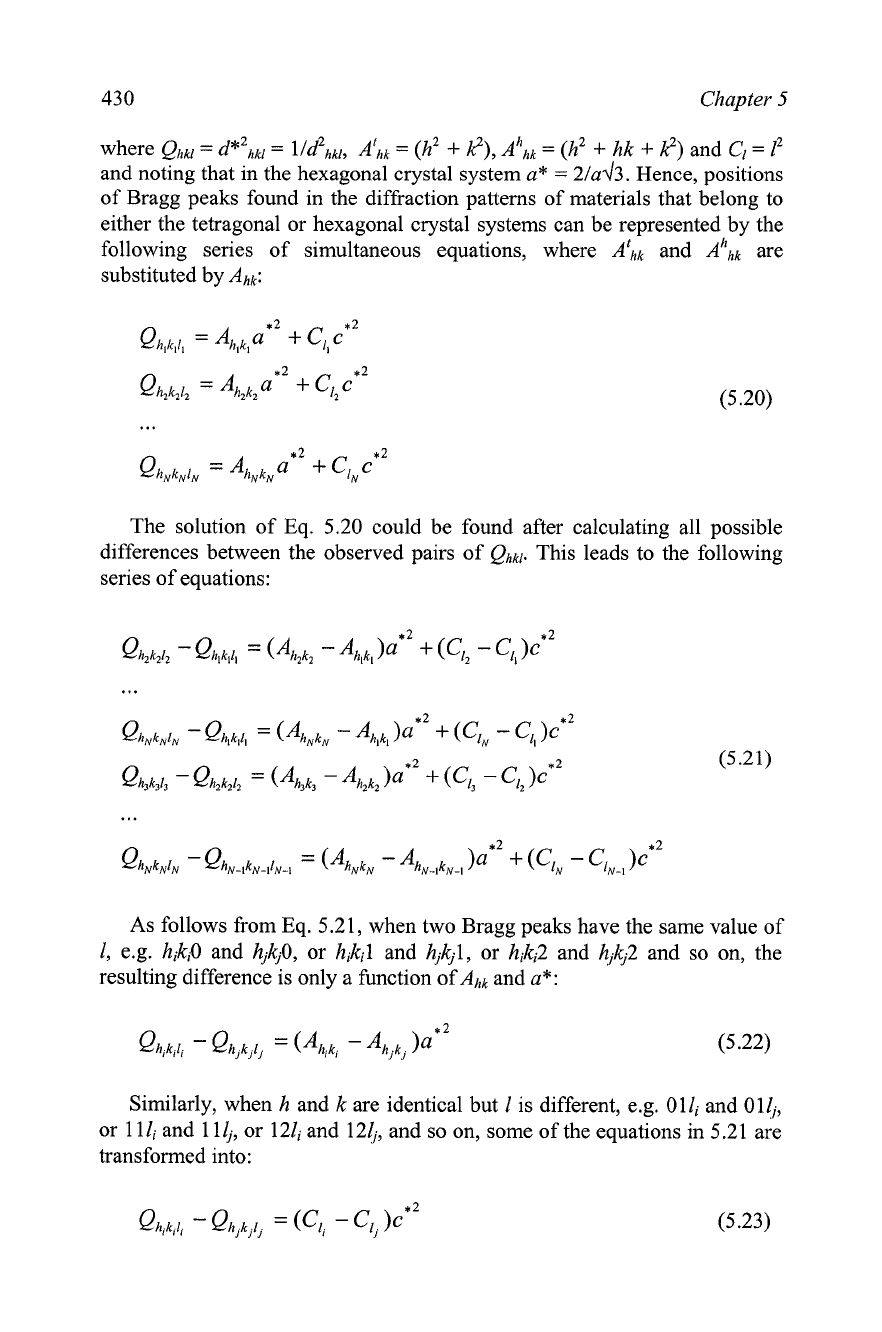
430
Chapter
5
where Qhkl
=
d*2hkl
=
l~d~~~~, Athk
=
(h2
+
k2),
~~hk
=
(h2
+
hk
+
k2) and Cl
=
P
and noting that in the hexagonal crystal system a*
=
21~43. Hence, positions
of Bragg peaks found in the diffi-action patterns of materials that belong to
either the tetragonal or hexagonal crystal systems can be represented by the
following series of simultaneous equations, where Athk and
~~hk
are
substituted by Ahk:
The solution of Eq. 5.20 could be found after calculating all possible
differences between the observed pairs of Qhkl. This leads to the following
series of equations:
As follows from Eq. 5.2 1, when two Bragg peaks have the same value of
I, e.g. hikiO and hjkjO, or hikil and hjkjl, or hiki2 and hjkj2 and so on, the
resulting difference is only a function of Ahk and a*:
*
2
(5.22)
Qh,,,
-
Qhjkj,
=
(Ahiki
-
Ah],,
)a
Similarly, when h and k are identical but 1 is different, e.g. Olli and 014,
or 1 1 li and 1 1 4, or 1 21i and 124, and so on, some of the equations in 5.2 1 are
transformed into:

Unit cell determination and refinement
43 1
Solving the indexing problem becomes a matter of identifying the
differences that result in whole numbers when divided by a common divisor
(a*2
and
c*~,
respectively). The expected whole numbers are shown in
Table
5.14 through
Table
5.16 for several small
h,
k
and
1.
It only makes sense to
consider these small values because successful indexing is critically
dependent on the availability of low Bragg angle peaks, which usually have
small values of indices.
The resulting whole numbers, expected as multipliers for the differences
in Q-values given by Eq. 5.23
(Table
5.14), are dissimilar from those
expected for Eq. 5.22
(Table
5.15 and
Table
5.16), and this property is used
to distinguish between
c*'
and
a*'.
Given the background considered above, the indexing of experimental
powder diffraction data assuming tetragonal or hexagonal symmetry may be
carried out using the algorithm illustrated in
Figure
5.11. First, all possible
differences between the observed Q-values are computed for several low
Bragg angle peaks. Second, the array of the obtained differences is analyzed
to find the most frequently occurring small values. Third, the found values
are tested with respect to whether or not the indexing of all observed Bragg
peaks is possible assuming that one of the quantities is and another is
c*~.
If the indexing is successful, both the crystal system and lattice
parameters are determined. If not, the found small values can be tested after
they have been divided by a whole number, usually between 2 and
4.
Again,
if indexing is possible, the problem is solved but if the indexing is
impossible, one or both found small values suspected as
a*2
and
c*~
should
be discarded and the search for a suitable pair of
a*2
and
c*~
continues.
When all potential candidates have been tested and no solution has been
found, then likely the assumption of tetragonal or hexagonal symmetry is
wrong, or the powder diffraction data contain impurity Bragg peaks at low
angles, which makes reasonable indexing impossible.
Table
5.14.
Possible values of integer multipliers for the differences defined in
Eq.
5.23 for
both tetragonal and hexagonal crystal systems
0
1
4
9
16
0
1
4
9
16
1
3
8
15
4
5
12
9
7
16
